Revitalize Your Blog: Repurpose Old Blog Content

Are you struggling to come up with fresh content for your blog? Do you have a backlog of old blog posts that have lost their appeal? If so, don’t worry, you’re not alone. Repurposing old blog content offers a valuable opportunity to maximize the value of your existing posts and engage your audience with fresh perspectives. In this article, we will explore the effective and creative ways to repurpose your old blog content.
Key Takeaways
- Repurposing old blog content can breathe new life into your digital presence
- Recycling and reusing old blog articles is an important part of content marketing
- Updating and optimizing your old blog posts is critical to align with current trends and audience preferences
- Repurposing blog content into various formats can engage your audience
- Tracking metrics and analytics for repurposed blog content helps you measure success
Why Repurposing Blog Posts is Important
In today’s fast-paced digital world, creating fresh and engaging content can be a challenge for even the most experienced bloggers. Repurposing old blog articles is an effective way to recycle and reuse existing content while maximizing its value. By taking the time to update and transform your old posts, you can offer your audience a refreshed perspective and save valuable time and resources in the process.
Recycling blog content can help you reach a larger audience while promoting your brand and increasing your online presence. By repurposing your old blog articles, you can tap into new channels and breathe new life into your content. Reusing old blog posts also helps to establish your expertise and build credibility with your audience over time.
With the sheer volume of content available on the internet, recycling and reusing old blog articles help your content stay relevant, and it’s a smart way to get the most out of your hard work. Repurposing is a win-win strategy that saves time and lets you deliver high-quality content to your readers.
Assessing and Updating Your Existing Blog Content
Updating your existing blog content is key to keeping your audience engaged. By reviewing your blog posts and assessing their performance, you can determine which ones are suitable for repurposing and updating. However, it’s important to keep in mind that not all posts need to be updated; some evergreen content may remain relevant without changes.
Assess Your Blog Content
The first step is to review your blog content and assess which posts are performing well. Use analytics tools to identify which of your blog posts are generating the most traffic, engagement and conversions. Look carefully at the topics, formats and language used in these high-performing posts to replicate their success in other blog content. Conversely, also identify which posts are not performing as well and consider repurposing and updating them.
Update Your Blog Content
When updating your blog content, consider the following strategies:
- Refresh your articles with up-to-date facts, events, and figures.
- Add new visuals or videos to make the content more engaging.
- Rephrase old sections to update the tone and style of the post.
- Add links to new and related content on your blog to boost internal linking.
- Remove any outdated information or broken links.
Updating your old content can positively impact the visibility of your blog in search engines and drive more traffic to your site. Keep in mind that some posts may need more extensive updates while others may only require minor alterations. Assess each post individually and tailor the updates accordingly.
Assessing and updating your blog content is a crucial step in maximizing the value of your existing content and improving your overall digital presence. Stay tuned for further sections that will equip you with creative repurposing strategies for your old blog content.
Creating New Formats from Old Blog Content
Repurposing old blog content is not only about reusing the same exact information, but also about presenting it in refreshing and engaging ways. There are a plethora of ways in which you can breathe new life into old pieces of blog content, but it’s important to choose the right format that aligns with your goals and target audience.
Below, we explore some creative strategies for reinventing your old blog content and creating new formats from it:
Infographics
Visual content has proven to be incredibly effective in grabbing the attention of busy audiences. You can repurpose old blog content into compelling infographics that showcase data and insights in a visually engaging way. Use tools such as Canva, Piktochart, or Venngage to create attention-grabbing infographics.
Videos
Repurpose your old blog content into videos that showcase your expertise and provide unique insights. Pick blog posts that lend themselves to visual storytelling, and create video content that highlights key points and offers new perspectives. You can create animated videos, whiteboard videos, or simply use a webcam and explain your ideas in front of the camera.
Podcasts
Not everyone enjoys reading or watching videos. Repurposing your blog content into audio format can help you reach a new audience that prefers to consume content on-the-go. Extract key points from your old blog posts and use them as the basis for a new podcast episode that offers fresh insights and perspectives.
Slide decks
If your old blog content is already structured in a list or step-by-step format, you can easily turn it into a slide deck or presentation. Platforms such as SlideShare or Google Slides allow you to repurpose old blog posts into slide decks that are easily shareable and visually engaging.
By utilizing these creative and effective strategies, you can breathe new life into your old blog content, reach new audiences, and present your ideas in new and innovative ways.
Repurposing Blog Content for Social Media
Repurposing old blog content can be incredibly valuable, especially when it comes to social media. By adapting and optimizing your existing blog posts for different social media channels, you can maximize your reach and engage with your audience in new and exciting ways while maximizing blog post value.
Adapting Content for Different Channels
When repurposing old blog content for social media, it’s important to consider the unique characteristics of each platform. For example, Instagram is a highly visual platform, so it’s important to use engaging images or videos to promote your repurposed blog content. On the other hand, Twitter has a limited character count, so you may need to condense your message to fit within the character limit while still maintaining the essence of the content.
Repurposed blog posts can also be shared on LinkedIn, Facebook, and other social media channels to reach even wider audiences.
Optimizing for Engagement
When promoting your repurposed blog content on social media, it’s important to optimize your content for engagement. This can include using attention-grabbing headlines, including calls-to-action, and tailoring your content to resonate with your audience.
It’s also important to be consistent with your social media strategy and ensure that you are sharing your repurposed content on a regular basis to maintain engagement and reach.
| Key Points | Best Practices |
|---|---|
| Adapt and optimize your existing blog posts for different social media channels | Consider the unique characteristics of each platform and tailor your message accordingly |
| Share your repurposed blog posts on different social media channels to reach wider audiences | Develop a scheduling strategy to consistently promote your content |
| Optimize your content for engagement | Use attention-grabbing headlines and include calls-to-action to encourage engagement |
Repackaging Blog Content as Visual Assets
Visual content is a powerful tool to engage and captivate your audience. By repurposing your old blog content into visually appealing assets such as infographics, videos, or slideshows, you can bring new life to your existing posts and reach new audiences. Not only does visual content help to communicate your message in a more compelling way, but it also provides a valuable opportunity to reinforce your brand identity and increase your online visibility.
Tips for creating compelling visual content
- Focus on the message: Make sure the visual elements enhance the message rather than distract from it.
- Simplicity is key: Keep it clean, simple, and easy to understand.
- Utilize contrast: Use colors, shapes, and images that highlight the information and draw attention.
- Be consistent: Use visual elements that match your brand identity, including colors, fonts, and design elements.
- Optimize for sharing: Make it easy for your audience to share your visual content on social media by including social media buttons and sharing options.
Examples of repurposing blog content as visual assets
| Visual Asset Format | Examples of Blog Content to Repurpose |
|---|---|
| Infographics | Industry statistics, how-to guides, comparison charts, trends. |
| Videos | Product demos, interviews, tutorials, event highlights. |
| Slideshows | Conference presentations, thought leadership pieces, data-driven reports. |
Remember, when repurposing your old blog content into visual assets, the goal is to provide valuable and engaging content for your audience. By following the tips for creating compelling visual content and exploring creative ways to present your information, you can breathe new life into your old blog posts and maximize the value of your content.
Transforming Blog Posts into Podcasts or Webinars
Repurposing blog posts can take many forms, and audio or video formats such as podcasts or webinars can be highly effective ways to recycle old content. By transforming your blog posts into spoken content, you can provide valuable information in a different format and reach new audiences who prefer to consume content through auditory channels.
To begin, consider which blog posts would be most suitable for repurposing into an audio or video format, focusing on those with engaging, informative, or insightful content. Once you’ve identified your candidates, consider the following strategies:
- Extract and expand upon key points from your blog post for use as the basis of your podcast or webinar.
- Re-record your blog post in a spoken format, taking care to enunciate clearly and pace your delivery for maximum comprehension.
- Utilize slideshows or graphics to accompany your spoken content, enhancing comprehension and adding visual interest.
When repurposing your blog content into audio or video formats, it’s essential to prioritize quality and relevance. Ensure that your spoken content is informative, engaging, and adds value to your audience’s experience. By doing so, you can expand your reach and make the most of your existing blog content.
Republishing and Updating Evergreen Blog Content
Repurposing old blog content is not only about creating new posts but also reinvigorating evergreen content to maintain its relevance and value to your audience. Evergreen content is timeless, and it remains valuable months or even years after publication. By republishing evergreen content, you can reach new audiences who haven’t seen it before and improve its visibility in search engines.
To update your evergreen content, consider the following techniques:
- Update the information: Ensure your content is still accurate and relevant. Identify any outdated statistics, facts, or examples and update them with current information.
- Add new sections: Analyze your article to determine if there’s anything missing that could make it more comprehensive. Consider adding new sections or points to enhance the value of the content.
- Revise the headline: Your headline is one of the most important elements of your blog post. By revising the headline, you can attract new readers and align it with current SEO strategies.
- Enhance the visuals: Improve the visual appeal of your old posts by adding new images, videos, or graphics. A visual refresh can make your content more engaging and increase its shareability.
Optimizing your updated evergreen content for search engines can further enhance its value and visibility. Ensure your content uses relevant keywords and meta descriptions and has a clear structure that meets current SEO best practices.
Leveraging Guest Blogging Opportunities
Are you looking for new ways to repurpose your old blog content and reach a wider audience? Guest blogging can be a valuable strategy to help you achieve these goals. By leveraging guest blogging opportunities, you can share your valuable insights on other platforms and reach new audiences with your repurposed content.
When identifying guest blogging opportunities, look for websites or publications that align with your niche, values, and target audience. Once you’ve identified potential opportunities, reach out to the website owners or editors to pitch your repurposed content idea. Be sure to provide a clear and concise summary of your proposed article and explain how it can provide value to their readers.
When repurposing your old blog content for guest blogging, be sure to tailor the content to the specific publication and audience. This may involve updating or optimizing the content to align with their style guidelines or audience preferences. By adapting your content for different platforms and formats, you can maximize the value of your old blog content and reach new audiences with your valuable insights.
Tip: When guest blogging, always include a link back to your own website or blog to drive traffic to your site and increase your online visibility.
Metrics and Analytics for Repurposed Blog Content
Tracking metrics and analytics for your repurposed blog content is crucial for maximizing blog post value. By measuring the success of your repurposing efforts, you can make data-driven decisions to continually improve the value and impact of your content. Let’s discuss some of the key metrics and analytics to keep in mind:
1. Pageviews and Unique Visitors
Pageviews and unique visitors are essential metrics to track to understand the overall performance and reach of your repurposed content. Pageviews indicate the total number of times your content has been viewed, while unique visitors show how many different individuals have engaged with your content. These metrics help you determine the popularity and reach of your repurposed blog posts.
2. Conversion Rates
The ultimate goal of repurposing blog content is to drive conversions, whether this means increasing email subscribers, generating leads, or boosting sales. Therefore, tracking conversion rates is vital to assessing the effectiveness of your repurposed content. By analyzing conversion rates, you can learn which repurposing strategies are working and which ones need improvement.
3. Engagement Metrics
Engagement metrics, such as social media shares, comments, and likes, demonstrate how well your repurposed content is resonating with your audience. High engagement rates indicate that your content is valuable, interesting, and relevant to your target audience. Tracking engagement rates can help you identify which types of repurposed content are most successful and inform future repurposing efforts.
4. Referral Sources
Tracking referral sources is key to understanding where your repurposed content is being shared and discovered. Referral sources can come from various channels, such as social media, search engines, or other websites. Analyzing referral sources helps you identify which channels are most effective at driving traffic to your repurposed blog posts and informs your overall content distribution strategy.
In conclusion, tracking metrics and analytics for your repurposed blog content is crucial for maximizing blog post value. By keeping a close eye on key metrics such as pageviews, conversion rates, engagement rates, and referral sources, you can continuously optimize your repurposing strategy and drive long-term success for your blog.
Tips for a Successful Repurposing Strategy
Repurposing old blog content can be a valuable way to breathe new life into your digital presence and engage your audience with fresh perspectives. However, to ensure a successful repurposing strategy, it’s important to follow some best practices and time-saving techniques. Here are some tips to help you get started:
1. Determine your goals and target audience
Before repurposing your old blog content, determine who your target audience is and what your goals are. Are you trying to increase website traffic? Boost engagement on social media? Generate leads? Having a clear understanding of your goals and audience will help you create content that resonates with them.
2. Choose the right content to repurpose
Not all blog posts are suitable for repurposing. Choose content that is evergreen, meaning it has a timeless quality that remains relevant to your audience over time. Also, consider the performance of your existing blog content and determine which posts have the potential for increased engagement.
3. Optimize for different formats and platforms
When repurposing blog content, it’s important to optimize it for different formats and platforms. For example, if you’re creating video content, make sure it can be viewed on different devices, such as smartphones and tablets. If you’re repurposing content for social media, optimize it for different channels, such as Facebook, Twitter, and LinkedIn.
4. Maintain high quality
Just because you’re repurposing old blog content doesn’t mean you should sacrifice quality. Ensure that your repurposed content is well-written, informative, and engaging. Use updated information and statistics to ensure that the content is fresh and valuable to your audience.
5. Track metrics and analytics
Finally, track the metrics and analytics of your repurposed content. This will help you determine the success of your strategy, as well as identify areas where you can improve. Analyze data such as web traffic, social media engagement, and lead generation to make data-driven decisions and continually improve the value and impact of your content.
Conclusion
As we have explored in this article, repurposing old blog content can have a significant impact on your digital presence. By utilizing strategic repurposing techniques, you can breathe new life into your existing posts, engage your audience with fresh perspectives, and maximize the value of your content.
Assessing and updating your existing blog content, creating new formats, repackaging as visual assets, transforming into podcasts or webinars, and leveraging guest blogging opportunities are just a few of the effective strategies for repurposing old blog content.
By keeping a close eye on metrics and analytics, you can continuously evaluate the effectiveness of your repurposing efforts and make data-driven decisions to improve the value and impact of your content.
With these tips and strategies, you can develop a successful repurposing strategy that ensures your old blog content stays relevant and valuable for years to come. Don’t let your old blog posts collect dust – repurpose them today to revitalize your blog and achieve long-lasting digital success.
Remember, repurposing old blog content is a sustainable and cost-effective way to increase your online presence and maximize your content’s value. Try out these strategies and see the results for yourself.
Thank you for reading this article on repurposing old blog content. We hope you found it informative and helpful.
FAQ
Why is repurposing blog posts important?
Repurposing blog posts is important because it allows you to recycle and reuse old blog articles, maximizing the value of your content. By repurposing, you can reach new audiences, adapt to current trends, and breathe new life into your digital presence.
How can I assess and update my existing blog content?
To assess and update your existing blog content, start by analyzing its performance. Determine which posts are suitable for repurposing based on factors such as relevance, popularity, and search engine rankings. Once you’ve identified the posts, update the content to align with current trends and optimize for improved visibility.
What are some creative ways to repurpose old blog content?
There are various creative ways to repurpose old blog content. You can transform it into different formats such as infographics, videos, or slideshows. You can also repurpose it into audio or video formats like podcasts or webinars. Additionally, you can republish evergreen content by updating it and leveraging guest blogging opportunities to reach new audiences.
Repurposing blog content for social media involves adapting and optimizing your posts for different platforms. You can create social media posts that highlight key insights from your blog posts, share snippets or quotes, or create visual assets like graphics or short videos. The goal is to maximize the value of your blog content and engage with your audience on social media channels.
How can I maximize the value of my repurposed blog posts?
To maximize the value of your repurposed blog posts, consider optimizing them for search engine visibility. Update the content based on current SEO practices, incorporate relevant keywords, and ensure the information is up to date. Additionally, track metrics and analytics to measure the success of your repurposing efforts and make data-driven decisions for continuous improvement.
What are some tips for a successful repurposing strategy?
Developing a successful repurposing strategy involves setting clear goals, identifying the most suitable posts for repurposing, and creating a content calendar to ensure consistency. It’s also important to repurpose strategically, adapting the content to suit different formats and platforms. Finally, don’t forget to track the performance of your repurposed content and make adjustments as needed.





